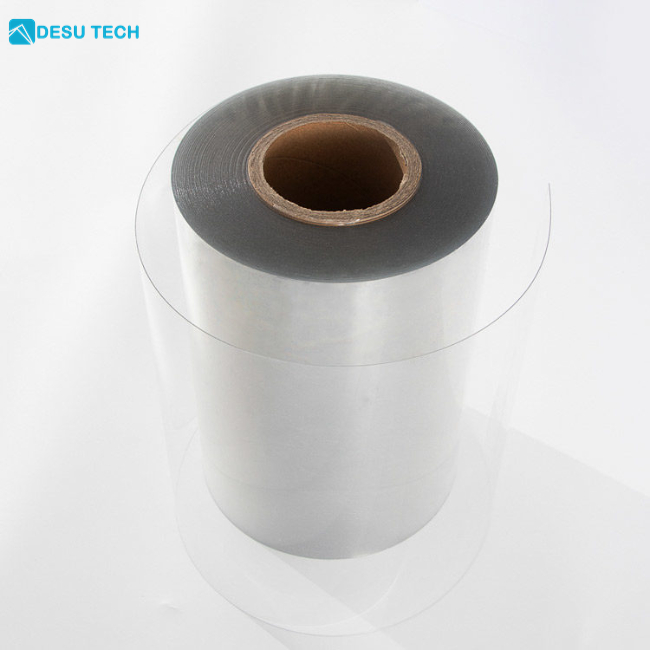
Specification
- Product name: Conductive Dissipative HIPS Plastic Roll
- Brand: DESU
- Origin: Shanghai, China
- Width: 300-1400mm
- Thickness: 0.2-2.0mm
- Weight: 50-150kg/roll
- Shape: Roll/Sheet
- Color: Black
- Surface resistance: 10^3 to 10^11 Ω/sq
- Molding Process: Vacuum forming
- Application: Electronic product tray
What is conductive dissipative HIPS plastic roll?
HIPS stands for High Impact Polystyrene, which is a type of plastic that is commonly used in packaging, appliances, toys, and other products. Conductive dissipative HIPS plastic rolls are a specific type of HIPS plastic that have been treated to make them electrically conductive and dissipative.
This means that these plastic rolls are designed to prevent the buildup of static electricity, which can be a major problem in manufacturing and other industries. When static electricity builds up, it can cause damage to sensitive electronic components, create sparks that could ignite flammable materials, and even cause painful shocks to workers.
Conductive dissipative HIPS plastic rolls are made by adding conductive and dissipative additives to the HIPS plastic. The conductive additives help to conduct electricity away from the surface of the plastic, while the dissipative additives help to spread the electrical charge out over a larger area so that it dissipates more quickly.
These plastic rolls are commonly used in a variety of industries, including electronics manufacturing, aerospace, automotive, and medical devices. They are often used for packaging sensitive electronic components, as well as for creating static-safe work surfaces and flooring in manufacturing facilities.


What is the resistance value of conductive dissipative HIPS plastic roll?
The resistance value of a conductive dissipative HIPS plastic roll can vary depending on the specific formulation and intended use of the material.
In general, HIPS (high-impact polystyrene) plastic with conductive or dissipative properties is designed to have a surface resistance in the range of 10^3 to 10^11 ohms/square, which means that it can help control static electricity by dissipating charges or conducting them safely away.
However, it is important to note that the actual resistance value of a particular HIPS plastic roll can be influenced by various factors, such as temperature, humidity, surface cleanliness, and handling practices.
Therefore, it’s best to consult the manufacturer’s specifications or test the material using appropriate equipment to determine its specific resistance value in your intended application.
What is the application of conductive dissipative HIPS plastic rolls?
Conductive dissipative HIPS plastic rolls are an important component in the protection of sensitive electronic components and the prevention of electrostatic discharge in manufacturing environments.
Some common applications for conductive dissipative HIPS plastic rolls include:
Packaging: The plastic rolls can be used to create protective packaging for electronic components, such as printed circuit boards, microchips, and other sensitive electronic equipment.
Work surfaces: Conductive dissipative HIPS plastic rolls can be used as work surfaces to protect against electrostatic discharge during the manufacturing process.
Cleanroom applications: The plastic rolls are often used in cleanroom environments to prevent the buildup of static electricity, which can attract and hold onto contaminants.
Flooring: The plastic rolls can be used as flooring in environments where electrostatic discharge is a concern, such as electronics manufacturing facilities.(But the conductive dissipative HIPS plastic rolls we produce are for packaging use only.)



Why Choose DESU TECH’s conductive dissipative HIPS plastic roll?
DESU TECH’s conductive dissipative HIPS plastic roll is a great choice for several reasons:
High-quality material: DESU TECH’s conductive dissipative HIPS plastic roll is made from high-quality materials that are designed to meet the highest standards for conductivity and dissipative properties.
Superior performance: This plastic roll is designed to provide superior performance in a wide range of applications, including packaging, electronics, and manufacturing.
ESD protection: The conductive dissipative properties of this plastic roll make it an ideal choice for applications where electrostatic discharge (ESD) protection is needed.
Versatility: DESU TECH’s conductive dissipative HIPS plastic roll can be used in a wide range of applications, from packaging to electronics manufacturing.
Customization: DESU TECH can customize the plastic roll to meet your specific requirements, including size, thickness, and color.
Cost-effective: DESU TECH’s conductive dissipative HIPS plastic roll is cost-effective, making it an ideal choice for businesses looking to keep their costs down while still maintaining high-quality standards.
Environmentally friendly: The plastic roll is recyclable, making it an environmentally friendly choice for businesses looking to reduce their carbon footprint.
DESU TECH’s conductive dissipative HIPS plastic roll is an excellent choice for businesses looking for a high-quality, versatile, and cost-effective material for their ESD protection and packaging needs.
This is the video of our production workshop. If you want more information, please click here contact me.
Other Products offered
In addition to conductive dissipative HIPS plastic roll, we can also provide you with PET plastic sheet roll, PP plastic sheet roll, PS plastic sheet roll and some other characteristics of plastic sheet.



